The sun rose as quickly as it had set. Suddenly there it was, a brilliant red in my view through the periscope. It was blinding…Suddenly I saw around the capsule a huge field of particles that looked like tiny yellow stars, there were thousands of them, like swirling fireflies.1
An astronaut appears…
The Space Race of the 1960s was a “theatrics of space” cultivated by NASA from an array of screen and space technologies, and within this arena, astronauts performed a vital function for they were witness to inexplicable sights never before seen.2 Often they appeared star-struck and dumbfounded: John Glenn, for instance, was astonished by the strange luminescent phenomena that appeared during his orbital flight aboard Friendship 7 in 1962. Even though Scott Carpenter’s subsequent mission provided an explanation for these mystical “fireflies”—they were the result of ice crystals forming around the spacecraft and then drifting free of it—Glenn’s encounter remains one of the many events that have granted NASA’s astronauts an equally mystical ability to see beyond visible boundaries. Conjugating up the blinding sun and in turn conjugated by it, the astronaut is revealed as a viewing agent that promises to grant sense and form to the act of viewing that which was previously invisible. Yet, those chosen for the Mercury missions were designed to act as scientific observers. In 1958, a medical team and representatives from the Space Task Group, NASA and the Special Committee on Life Sciences constructed a duties analysis that clearly stated: those who successfully applied to Project Mercury would “ serve as the scientific observer; that is, to go beyond what instruments and satellites can observe and report.”3 Glenn, then, was but one of the many viewed and viewing agents who were entrusted with ensuring that the phenomena beyond the horizon could be rendered sensible in scientific terms to those who remained back on Earth.
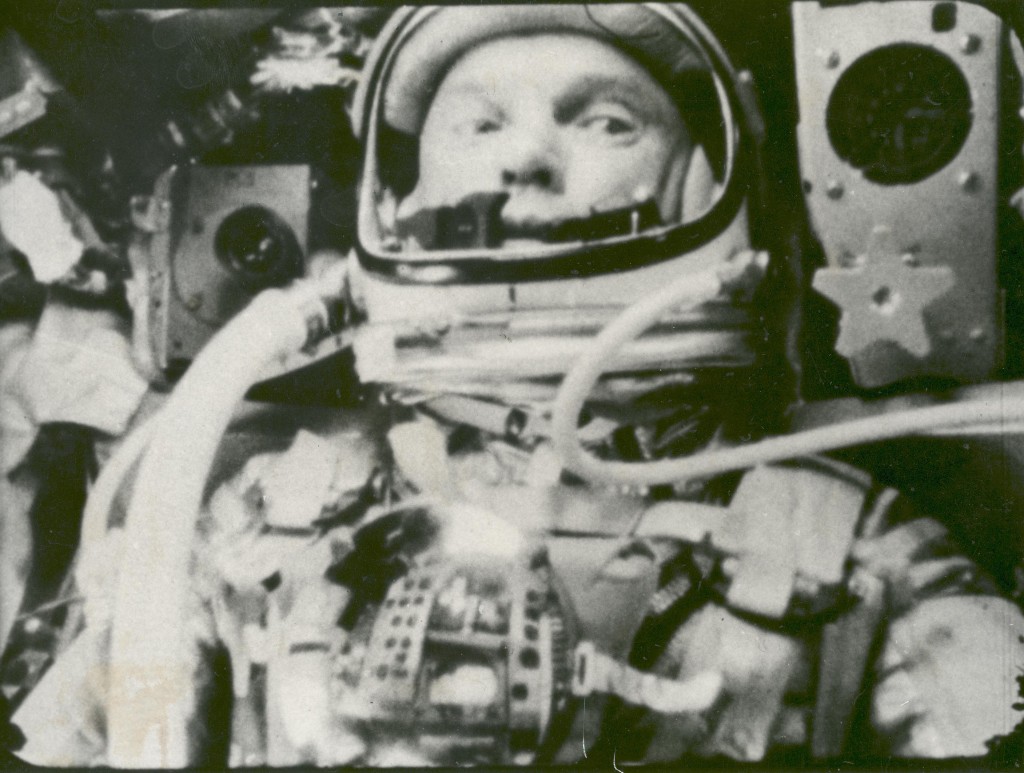
Figure 1. John Glenn during his flight on Friendship 7. Image courtesy NASA. GRIN DataBase Number: GPN-2002-000075
The world of human spaceflight (particularly limited to NASA’s endeavors) is a domain of techno-science and, as Donna Haraway has argued, technoscience is inescapably tropic.4 A particular form of figuration has dominated, however: one that has managed multi-vocal networks and heterogeneous knots of agents and artifacts into a coherent narrative of historical progress and a homogenous domain of knowledge making. The socio-technical operations and storytellng practices that constitute contemporary technoscience have inherited, Haraway argues, the “Christian practice of reading the story of Christ into Jewish scripture [so that] history is fully contained in the eternal plan of Divine Providence, which alone can supply the key to historical meaning”.5 Her proposition is just as significant for the figural acts that have called up the astronaut. On February 1st, 2003, after the Columbia shuttle accident, President Bush spoke: “In the words of the prophet Isaiah, ‘Lift your eyes and look to the heavens. Who created all these? He who brings out the starry hosts one by one and calls them each by name. Because of his great power and might strength, not one of them is missing’.6 Though astronauts died in the accident (and were literally missing as remains were strewn across several states) by (re)turning to scripture, there is still a figure who is able to be named as the one who will fulfill (because they already have) the promise of salvation. More recently, at the memorial for Neil Armstrong on September 13th, 2012, which was streamed live on NASA TV and its website, astronaut Eugene Cernan called out to the dead: “Neil… almost a half a century later you have now shown once again the pathway to the stars… It is now for you a new beginning but for us, I will promise you it is not the end”.7 Much as the figures of Christian doctrine (particularly of the millenarian variety) pointed towards the end (which was always the beginning), one astronaut gestures towards another, who has come before and will thus arise again. Astronauts are not just agents sent to the stars, they have acted as the figurative means to fulfill the manifest destiny that has fuelled the teleological thrust of their rocketships.
Astronauts tend to arrive on the scene, so to speak, always supercharged with significant meaning. The science fiction film scholar, Vivian Sobchack acknowledges this when she calls the astronaut a “thing” that “should not be taken literally” and one easily charged with “other things and ideas and associations”.8 Astronauts appear, as if by default, to automatically articulate, variously: the masculinist, cybernetic, post-capitalist, neo-liberal geneologies of the American Rocket State.9 Or they are invoked from the dead to lament a lack of imagination that has led to the utterly unremarkable sceneography that is contemporary spaceflight. 10 Whilst innately suspicious of its mimetic thrust, Haraway does not deny figuration; instead, she argues that, especially in the domains of technoscience, it must be made explicit.11 Likewise, the figurative economy to which the astronaut is indentured needs addressing. Whilst the astronaut has operated as a symptom of the socio-political domain of space travel, the rhetorical operations of critical scholarship also depends upon its figurative work. For instance, Robert Romanshyn in his Technology as Symptom and Dream turns to a tiny figurine, he calls “The Little Cosmonaut”, and suggests it is haunted by a “shadow which is ignored”.12 This figurine thus embodies the problem of the ‘human condition’: a hidden “wish to take leave of a flesh so fragile and so frail” and therefore ignore the pressing matter of a responsibility to the planet in favour of the quest for extended human space flight.13 The form of this particular astronaut then becomes both the material and sybmolic instantiation of the terrestrial myopia that, in a kind of hermeneutic feedback loop, Romanshyn seeks within the contemporary cultural condition. In the liturgical reading of Christ into scripture, the promise of salvation embodied in the Christ figure is fulfilled in the act of interpretation.14 In critical scholarship like Romanshyn’s, the astronaut is the figure that fulfills the rhetorical ends to which it is indentured, used as the thing that guarrantees that what it articulates is a matter of fact.
Addressing the astronaut as a viewed and viewing agent requires engaging in a practice of figuration. But is it possible to call up the figure of the astronaut without falling prey to the kind of self-fulfilling prophecy that it often engenders? Figurations, Haraway argues, are “performative images” and if approached as such, they might engender the kind of self-reflexive, situated practices that can map relations of knowledge, practice and power as always differential and contested.15 What if, then, rather than being called up in the light of the sun or as another starry host, the astronaut is figured as a blind spot? Encased within a specially designed observational apparatus (which actually limited his own view), John Glenn was the figurative means by which newly visible phenomena could be translated in absolutely transparent terms. When the blinding sun appeared, Glenn had to apply a special filter to the clear lens of the periscope to avoid damaging his eyes and developing blind spots. A blind spot is a burn mark on the retina, known medically as a scotoma that is caused by ultraviolet light and obscures part of the visual field. Within the theatrical arena of early space travel, the astronaut is also acting as a blind spot, a visible, material agent that is also able to deflect that which might be too blinding, not only in physiological terms but also because the newly visible required translation if it was to be managed within the technoscientific domain. Ironically, however, right there, ultimately visible, this blind spot also draws attention to the epistemological dangers involved in opening up the visual field to all that could not previously be seen, in fact, the transcripts of Glenn’s mission convey the tug of war that occurred between Glenn and Mission Control as his attempts to describe the strange sights that appeared before him are consistently interrupted by the Capcom asking him to relay readouts from instruments on such matters as yaw, roll, pitch and altitude and report on his physiological condition.16
In this situation – one that is literal and figurative, symbolic and material – the astronaut is as troubling as a dark spot on the retina. Contaminated with an(other) trope—the blind spot—the astronaut begins to work in a manner akin to those “optically dense” entities that Haraway seeks.17 The astronaut emerges as both visible and invisible: necessarily so if it is to fulfill its function as a viewed and viewing agent and yet also making evident the contradictory and contested aspects of this situation. This in/visible figure merits further consideration for it is not limited to those who have actually undertaken space travel or contributed to its tropic operations. The astronaut also appears on the film screen but, as developed in the following discussion of the film, Contact (Zemeckis, 1997), it can also disappear and, in turn, open up other ways of making sense of what was once invisible than those to which the astronaut has been previously indentured.
@ the horizon of invisibility
Contact is a science fictional thought experiment concerning the possible existence of extra-terrestrial life. The primary character is, Ellie Arraway, who, as a child, dreamt of journeying to the stars. Days spent with her father making contact with voices adrift in the ether with a CB radio equipped her well for a job at SETI, searching for signals from extraterrestrial regions. Ellie is actually the one who receives an extraterrestrial signal and eventually solves its puzzling instructions so that the alien spaceship can be built. She is not chosen for the first launch to Vega but instead only witnesses the preparations and the sabotaging of the first mission. Ellie is chosen as the astronaut for the second, unpublicised, mission and is launched into a hyper-dimensional network of wormholes to the planet Vega where she meets these aliens. The question as to whether these aliens exist is played out in the film through exchanges between Ellie who is committed to scientific rationalism and the priest, Palmer Josa, who insists that the alien’s signal should be interpreted within the context of religious faith. As the Vegans appear to Ellie in the form of her long dead father within a simulation of her childhood drawing of Pensacola and she returns to Earth without proof of the meeting, the film never really answers the question of whether these aliens actually exist.
Contact also offers an opportunity to reconsider the figurative work of the astronaut as a viewed and viewing agent. Ellie is more than the means to represent another astronaut, she is a figure written out of a ‘’complex interconnection (a ‘circulation’) between real people, personae, fictional characters and narrative functions.18 In his discussion of film figures, Bill Routt emphasizes the term “excribe” to convey that such figures are instances of a typology drawn from myth and allegory. Haraway performs her practice of exscription by using directional signals like @ to mark up (and mutate) her figures as they inhabit a “particular space-time modality” and thus the title to her book reads: Modest_Witness@Second_ Millennium.FemaleMan©_Meets _OncoMouse™.19 Contact’s astronaut is an instantiation of the ‘typology’ of the astronaut that emerges from specific aesthetic and material situations. At the time of the film’s release, NASA was reconfiguring spaceflight and the cosmos into a desktop universe with computing technologies. In 1997, the Jet Propulsion Laboratory proclaimed that the Pathfinder mission—that not only involved sending a robotic explore called Sojourner to Mars but also the development of a web portal that could replicate, store and transmit Martian images and information across a commercial global infrastructure of 1,300 reflector sites—would lead to the final “merger of outer space and cyberspace”.20
In the same period, science fiction was contested territory. In 1992, Brooks Landon released his book The Aesthetics of Ambivalence: Rethinking Science Fiction Film in the Age of Electronic Reproduction to make the argument that science fiction scholars needed to rethink their object of study and methods of analysis.21 It was no longer the province of literature to imagine worlds beyond the horizon and thereby offer a mirror to current conditions; but SF film. Moreover, SF film did not represent alternate visions of the world but, rather, acted as the aesthetic-technological form to poetically map contemporary conditions.22 Coining the term, a horizon of in/visibility, Landon indicated two interrelated shifts then occurring: that the mapping performed by SF film was shifting with the increasing use of computing technologies and that the integration of such computer technologies meant that the contemporary world was itself, increasingly, science fictional. In the context of both screen and space technologies, Contact’s astronaut emerges @this horizon of invisibility.
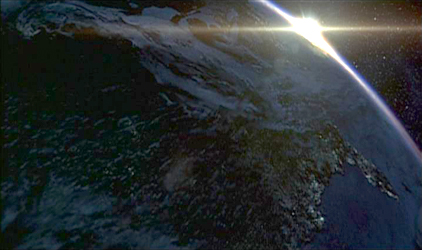
Figure 2. Contact begins @ the horizon of in/visibility. (Screenshot: Contact)
Contact begins by gesturing towards this horizon of in/visibility with the longest computer generated sequence (4,710 frames created by Sony Imageworks) in the cinema thus far. The Earth appears: as if seen from a window in low orbit, the planet is encircled by an aura of sunlight and slowly rotates to the tune of a multitude of radio and television transmissions. The view shifts, spirally out towards Mars, through the meteor belt, Jupiter, and the rings of Saturn and into interstellar space where nebulae swirl and stars glitter like the dust of diamonds. Radio transmissions accompany the journey—brief snatches of popular music, the dulcet tones of Frank Sinatra singing Flying to the Moon, the voice of astronauts declaring a major malfunction, news broadcasts of President Kennedy’s assassination and the Moon landing, the theme music from the Star Trek television series. These sounds begin to fade and the view disintegrates until there is only silence and white light—a vast nothingness.
This cosmic trip is almost as hallucinogenic as the one undertaken by Chuck Yeager in 1947, a test pilot who‘pushed the envelope’ and broke the sound barrier in the era just before NASA enlisted its astronauts. Semi-fictional accounts of his flight render it in highly visual terms: Tom Wolfe writes in the novel The Right Stuff: as “the speed topped out at Mach 1.05 Yeager had the sensation of shooting straight through the top of the sky. The sky turned a deep purple and all at once the stars and the moon came out—and the sun shone at the same time.” 23 In the test pilot jargon of the pre-Mercury days pushing the envelope was a flight-test term that referred to the limits of a particular aircraft’s performance. However, it was also a kind of special effect: along with “looping”, “falling-leaf roll” and “figure of eight”, it “opened endoscopic tunnels and even brought ‘blind spots’ with the most astounding topological field”.24 In the film version of The Right Stuff (Philip Kaufman, 1983), this aeronautical special effect is visualised as a shift from black and white footage to technicolour and a 70mm Panvision format. Moreover, the material act of breaking the sound barrier is enacted as an overwhelmingly visual experience as the frame of the cockpit (which doubles for the screen) disappears and the realm of the supersonic threatens to overwhelm the limits of Yeager’s (and the viewer’s) vision. In his discussion of this film, Scott Bukatman argues that Yeager is exemplary of the “provisional guides” that appear in SF cinema to negotiate its “new way of seeing”.25 The “central pilot figure serves as a… visual anchor” for the potentially overwhelming impact (on both them and their viewer) when special effect technologies render the invisible, perceptible.26
Contact does not, at least initially, provide such a figure for its cosmic trip. However, the viewer is not left adrift in nothingness for the frame of a doorway appears, reflected in a wide open and distinctly human eye and the camera enters it. Thus, the scene shifts to Earth and the familiar setting of a child’s bedroom where Ellie and her father appear, using their home radio to speak with another operator, K4WLD, who is 1,116 miles away in Pensacola. Though not yet an astronaut nor even a test pilot, Ellie is the anthromorphic ground for the camera’s disorientating journey through the digital, and her function as such is further reinforced because she also appears as the visible source for the sounds that accompanied it. We first hear Ellie before we see her: speaking to KWLD. Her voice, like those of NASA’s astronauts and Frank Sinatra that were heard during the cosmic zoom is acousmatic. In his work on voice in the cinema, Michel Chion coins the term “acousmatic” to refer to the audible realm that extends beyond the limits of the screen and is associated with the figure of the “acousmệtre”.27 When Ellie appears on screen, in her bedroom listening to the radio, she becomes what Chion calls the ‘visualized acousmệtre’, the figure through which the voice is triaged to a visible source on the screen. Even before traveling to the stars, Ellie Arraway is already an astronaut, appearing on screen as the visible anchor for what was previously invisible and inaudible.
to bear witness
In a “movie about windows and monitors; looking out of windows onto grand vistas, and seeing things played back on monitors from someplace across the world”,28 this proto-astronaut is also able translate what appears on the screen into an act of knowledge making. Her work as such is evident in the scene where J.R. Haddon (the entrepreneur who will eventually fund the second mission that will launch Ellie to the stars) shows Ellie the pictograms that comprise the alien’s message on a television screen.
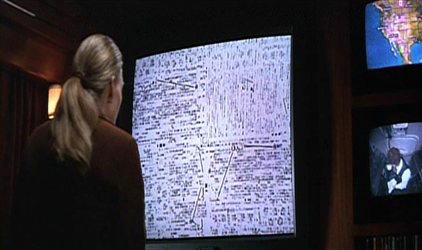
Figure 3. The message sent by the aliens and designed to be decoded by the proto-astronaut (Screenshot: Contact).
As the camera tracks closer to the screen, he explains how the three pieces of this jigsaw puzzle fit together. They begin to morph together as if he had from his remote location aboard the orbiting space station, pressed a button on a remote control. Ellie witnesses the 2-dimensional representation transform into a 3-dimensional cube containing the primer to the alien’s message. The camera then tracks out from this television screen to another location, revealing Ellie looking at another television screen that represents the solution to the puzzle and upon which three equations are shown.

Figure 4. Instructions in knowledge-making: the solution to the alien’s message as viewed by Ellie and explained to her audience (Screenshot: Contact).
She then explains to her audience, the Presidential scientific advisors, that the symbols that appear on the television screen represent “instructions for building some kind of machine”. This series of edits not only shift Ellie (and the viewer) from the scene where she views the pictograms to seeing their solution on another screen but suggest that she has journeyed into the screen-space of the television and emerged from it with the solution. Ellie’s capacity to solve the problem might be explained on the level of the diegesis by her training in the mathematical sciences, but it is her capacity to figuratively navigate the screen and thereby decode its secrets that is significant. Ellie witnesses knowledge-making occur and she also enacts it.
Even before she travels into the cosmos, Ellie undertakes the work of those astronauts who have previously journeyed into a previously invisible realm and translated such acts into the techno-scientific domain. Her authority to do so is granted because the same screen and computing technologies-used to visualize the cosmic zoom from which she appeared are deliberately deployed by Zemeckis and his production teams to conjure up the political theatre within which NASA’s astronauts performed. The dodecahedron-shaped apparatus based upon the “basic idea of a nucleus of an atom” and housing the silver-chromium pod is seamlessly enmeshed with views of the actual crowds that have gathered at Cape Canaveral to watch shuttle launches.29 For the first, but unsuccessful flight to Vega, and thanks to further compositing techniques, President Clinton’s appears in conversation with David Drumlin (the first astronaut selected for the mission) in a form of political theatre designed to be as “startlingly real” as those scenes in which NASA astronauts were photographed with Presidents Kennedy and Nixon.30 If the Space Race constituted an “apparatus of production of what could count as knowledge”, then this scenography is equally a theatre of persuasion.31 Haraway has argued that laboratories, such as Robert Boyle’s in which he demonstrated his invention of the air pump to patrons of the Royal Society during the mid 17th century, were theatrical arenas, neatly cordoned off from the world and yet porous enough to accommodate those who were required to bear witness to the material practices and constitutive acts that occurred within them and, in turn, to make them outside this specialized domain.32 Similarly, NASA’s astronauts were considered legitimate observers because they not only had special access to the techno-material practices of NASA’s operations (including the spacecrafts) but also translated the knowledge-making that occurred within them into a public arena. In turn, they were legitimated as witnesses because their acts were witnessed by a special community of space enthusiasts, science specialists, media journalists and other astronauts who “had to hear the astronauts speak from space… had to watch the rockets lift off… had to know it was real. After all, it was produced for them”.33
Contact creates a similar scenario of witness and witnessing: The first, but unsuccessful launch is shot in “standard television news sound-bite fashion” with the space-travel apparatus, the technicians and the astronaut chosen in Ellie’s stead (David Drumlin) for the first test flight witnessed by viewers on television screens within their homes, by the technicians and operators in the mission control tower who view the launch pad on various monitors and through the tower’s windows and, thirdly, by the crowd that gathers on Cocoa Beach to watch the flight test across the (computer generated) water.34
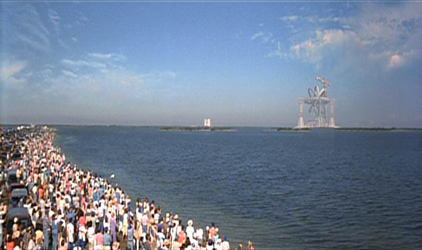
Figure 5. Contact reenacts NASA’s theatrics of collective witnessing (Screenshot: Contact).
Watching the pre-launch drama unfold on the television screen in her bedroom, she is a member of a collective community of witnesses who can only indirectly view the theatrics of space choreographed for them on the screen. Once inside Mission Control during the test, however, her witnessing reaches another stage as she watched the preparations of the launch through a variety of viewing apparatuses: binoculars, computer screens and monitors. Rotating one of the cameras that is remotely recording the technicians and astronauts at work on the gantry that houses the alien technology, Ellie identifies one of the technicians as a potential saboteur. As she did with the puzzle of the alien’s message, she is granted the capacity to make knowledge through the screen. Now both a collective witness and a member of the specialized broadcast community, she is granted the ability to decipher the operations of the apparatus and give testimony on its behalf and translate it into the public domain and instigate “compelling belief and collective action”.35
Witnessing is not, however, just a matter of observation: those able to attest to the knowledge constituted within the laboratory must be modest, visibly present and yet also absent. Neil Armstrong is perhaps most exemplary of the astronaut as modest witness: “Carrying on rapid fire conversation with the computer” and unable “to bring to bear (sic) large changes in (his) force application” while walking on the Moon.36 In fact, Armstrong’s articulations were often so transparent that it was difficult to distinguish the astronaut from the computer as Tom Wolfe ironically recounts in The Right Stuff:
You’d ask him a question, and he would just stare at you with those pale-blue eyes of his and you’d start to ask the question again, figuring he hadn’t understood, and – click – out of his mouth would come forth a sequence of long, quite, perfectly formed, precisely thought-out sentences, full of anisotropic functions and multiple-encounter trajectories, or whatever else was called for. It was as if his hesitations were just data punch-in intervals for his computer.37
Reporting observations back to Houston and reading data from instrument panels (much as Glenn was asked to do during his orbits of the Earth) Armstrong acted as the “legitimate and authorized ventriloquist” for the apparatuses of production within which he was situated.38
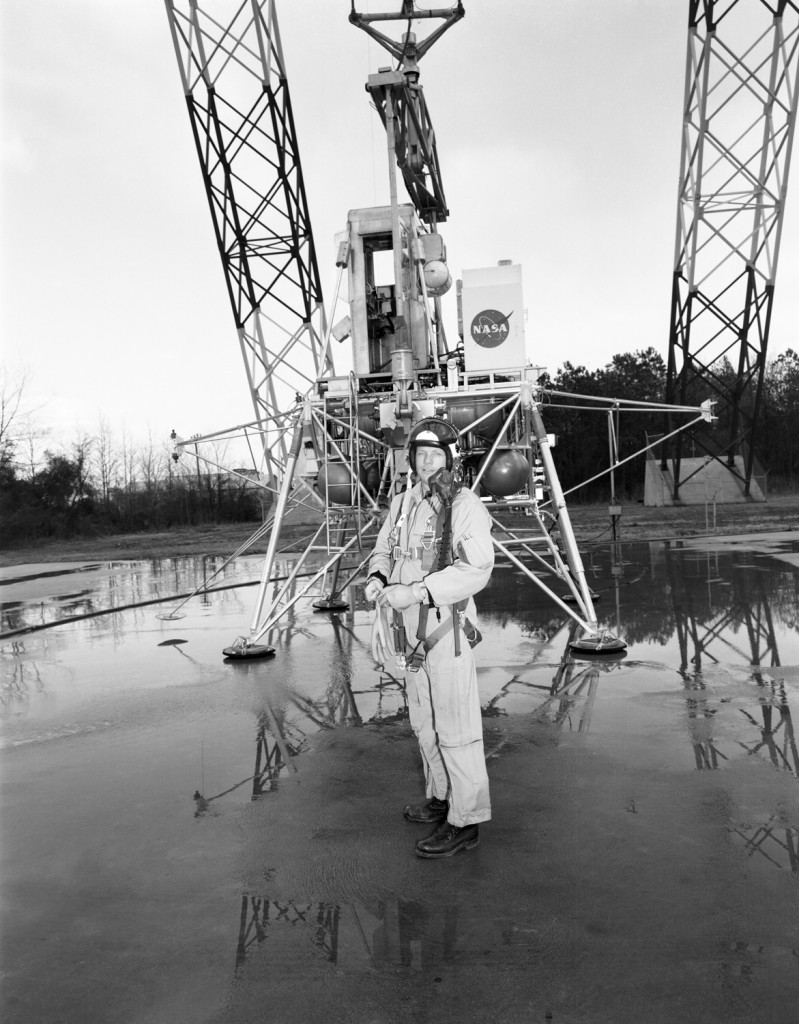
Figure 6. The fully equipped ventriloquist: Neil Armstrong at the Lunar Landing Research Facility (LLRF) 12th February, 1969 (Langley Research Centre, image L-1969-01692).
Anticipating the signal from Vega, Ellie, too, is also constituted as a modest witness to the silent matter of fact operations of the apparatus in which she is integrated. Draped in a bright-red scarf, wearing headphones and seated cross-legged in the desert against the backdrop provided by the giant antennas of the Very Large Array in New Mexico, she reenacts Neil Armstrong’s famous pose in front of the Lunar Landing Research Facility at Langley. Equipped with all the technical accoutrements, both figuratively disappear for only in so doing can knowledge-making be enacted as if it were inevitably apparent.
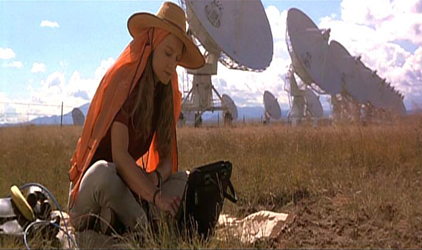
Figure 7. The astronaut as mute witness: Ellie listens to the Very Large Array in New Mexico (Screenshot: Contact)
and then disappear…
If Ellie Arraway is already prefigured as an astronaut through her acts of modest witnessing, then her work as such appears to be fulfilled when she is actually chosen for the second launch. Seated behind monitors and equipped with a video recorder and microphone in the form of a tiny headset, she is a kind of reincarnation of Laplace’s Omniscient Calculator, the figure that has been given permission within Western cosmology to give a “comprehensive and accurate running commentary on the entire historical action of the universe but from outside it”.39 Yet, once the launch to Vega begins and the circular rings of the alien apparatus begin to spin, Ellie becomes invisible to Mission Control. How, then, can this astronaut enact knowledge-making if her community of witnesses is rendered blind, deaf and dumb?
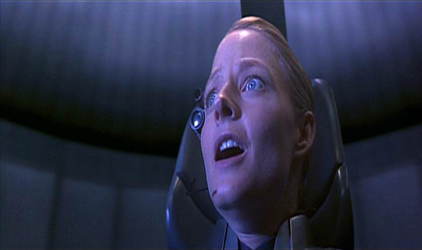
Figure 8. “It’s a star”: Ellie encounters wonders (Screenshot: Contact)
An event that occurs during Ellie’s trip is revealing in this respect. At an intersection in the intergalactic network of wormholes through which it’s transported, the pod comes to a complete stop. Floating inside, Ellie looks through its now transparent membrane and is struck by something that suddenly appears just above her. “It’s a star!” she exclaims. Astronauts have seen such stars before; John Glenn called them fireflies, others spoke of seeing stars in liturgical terms. The Apollo 8 crew looked back at the Earth on Christmas Eve, 1969, and read the Creation myth from Genesis to the biggest television audience in history: “God [and the astronauts] said: “Let there be light, [they said] and there was light. And God saw the light, that it was good: and God divided the light from the darkness”.40 When Ellie encounters the stars, it appears inevitable that she will fulfill, like her predecessors, the Divine plan for which NASA’s astronaut were constituted.
However, like John Glenn, this astronaut struggles to articulate the significance of what was once invisible. With no witnesses to the event, Ellie speaks aloud for the purposes of recording it and states” there are “no words to describe” it. Though initially “struck” by the star, she is “not struck dumb”;41 but figures, instead, another way of making sense of such sights. In his book, The Rainbow, Wonder and the Aesthetics of Rare Experiences, Philip Fisher argues that, along with the rainbow, the night sky filled with stars is a “candidate for wonder”.42 The sudden appearance of the star (or Glenn’s fireflies for that matter) fulfills the condition of first sight that is necessary, Fisher argues, for an object to become a wonder and, in turn, activate a process of wondering. Ellie’s exclamation at the sight of the star appears equivalent to the “Ahh”, the instant when that which is “puzzling snaps into sharp focus” and “something is imposed on us for thought”.43 Fisher argues that it is only the spatial arts, like architecture, that offer opportunities for wonder as the “visual presence of the whole state or object can be seen”.44 Yet, his description of wondering as “a slow unfolding of attention and questioning [that] takes place in the presence of the work” is figuratively enacted when Ellie greets her star.45
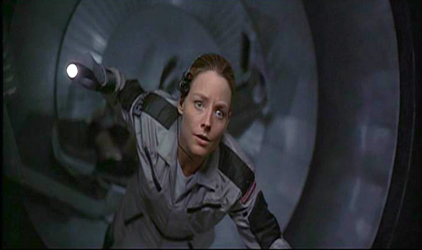
Figure 9. Enfolded within the labyrinth, the astronaut enacts a poetics of wondering (Screenshot: Contact).
After the star is revealed, a reverse shot shows Ellie floating in the pod, looking upwards and to the right of the screen (at this star). Without a horizontal axis, the circular pod is transformed into a series of concentric rings that spiral away behind her. This spiral is doubly significant: both a motif for the labyrinth that this astronaut is navigating as well as the key to figuring out that which appears during the journey. In another context, Angela Ndalianis has argued that the aesthetic form of the labyrinth invites a form of interpretation that is itself labyrinthine: in that “the construction of the labyrinth itself – its ‘paradigmatic’ level – becomes a significant source of the work’s meaning”.46 The form of a multi-cursal maze is circuitous but nevertheless teleological as its puzzle will eventually be solved, ostensibly at the exit.47 If this labyrinth is multi-cursal, then the star is nothing but a “bivium”, a choice between bifurcating paths that will lead to an inevitable resolution and eventual explanation (when Ellie exits the wormholes and meets the Vegans). However, it is polycentric: full of ambiguity, [with] a circuitous design [that] prescribes a constant doubling back [and] a double perspective”, it offers multiple pathways that branch off and connect at unanticipated intersections in a manner that cannot be predicted.48 The astronaut who appears within this labyrinth is the figurative maze-treader, subject to the disorientating and confusing aspects of a situation with no guaranteed solution. Wondering differs from “what a philosopher would call knowing”.49 Wondering is still bound, Fisher argues, to the activities of science and its methods of inquiry but only in so far as science is “the power to notice and put in question, rather than the power to answer”.50 It is no wonder then that Ellie’s journey to Vega remains suspect for on her return to Earth, Mission Control discovers that the 18 hour recording of her journey is just static.
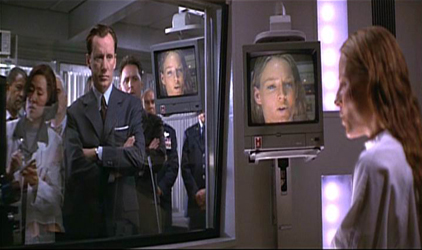
Figure 10. The troubling matter of the in/visible astronaut: Ellie as she is subjected to interrogation after her return from Pensacola (Screenshot: Contact)
Without recourse to this data, she is questioned and scrutinized through an array of screens and monitors. When Armstrong, Aldrin and Collins, the Apollo XI crew, returned from the Moon they were also subjected to a similar form of epistemological decontamination. Emerging from the spacecraft dressed dressed in biological isolation garments and “looking like three men from another planet”,51they reappear behind a screen, safely contained by its material and symbolic limits.
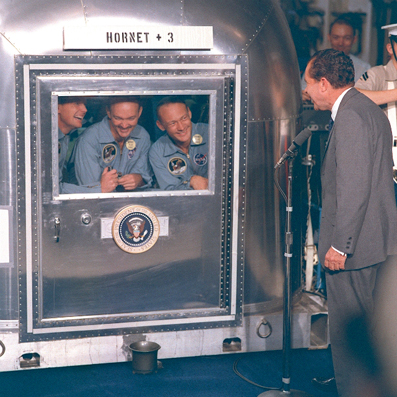
Figure 11. Post-decontamination: The Apollo 11 astronauts safely contained within the screen as they are welcomed back by President Nixon and the world, 24th July 1969 (Image Courtesy: NASA, Johnson Space Center, Image # S69-21365).
Astonished by fireflies or overwhelmed by the realm beyond the sound barrier as was Chuck Yeager in The Right Stuff, astronauts have embodied the fear and dread that seems inevitable if the borders of the visible are breached. Named as the technological sublime by Scott Bukatman, following such logic would mean that this symbolic process of decontamination is the means to assert mastery and control over the technologies (both of spaceflight and the screen) that destabilize the parameters of the known world.52 However, the astronaut that reappears in Contact’s theatre of persuasion refuses to be managed so. Dismembered across a doubled and doubling array of monitors and screens within and outside the ‘interrogation chamber’, she dis/appears -and not only in terms of the visible.Chion argues that film can “play with showing, partially showing, and not showing” through the figure of the acousmệtre.53 When Ellie is first heard, but not seen, she operates as the ‘complete acousmệtre, who is not-yet-seen’ (yet is liable to appear at any moment). When she disappears (though she is still actually visible on the film screen) she takes on the figurative work of the ‘already visualized acousmệtre’, one who has acted as the visible anchor for the acousmatic realm but who might disappear back into it at any moment. Reappearing on the screen, it is as if she still channels the uncanny and contingent properties of the acousmatic realm. Chion has spoken of the acousmệtre as a “kind of talking and acting shadow” [that] wanders along the surface (of the screen), at once inside and outside, seeking a place to settle”.54 As this dis/appearing astronaut wanders across screens, she plays a game of hide and seek that should draw attention to the fact that the astronaut need not always fulfill the purposes for which it was (once) and still is conjugated.
A figure in film, Dudley Andrew contends, “is reducible neither to its proper sense nor to some timeless process it exemplifies, for it has the ability to change the rules of the discursive game in which it participates. [It] invites us to fill in that space through interpretation.55 Contact‘s dis/appearing astronaut appeared during a period when the horizons of the visible world were shifting and it was the work of SF film to poetically map such conditions. Like those figures that Haraway conjugated for the cultural conditions contemporaneous to her writing, the astronaut reappears here a doubled and doubling instantiation of a blind spot: like astronauts such as John Glenn, Contact renders the astronaut visible to modestly witness the invisible. Its disappearance, however, only serves to amplify the contested and contradictory position from which the astronaut has always been conjugated as a viewed and viewing agent. Enfolded with the star into the labyrinth, this wanderer who wonders is involved in an “ongoing fragile project of making sense”.56 In turn, all those who were and are her witnesses are asked to attend to how the world is ongoingly crafted through a mixed web of contested practices to which we must commit if were are to think otherwise about how the invisible is imaged and imagined.
- John Glenn in John Glenn & Nick Taylor, John Glenn: A Memoir. (Bantam Books: New York 1999), 265 ↩
- The term ‘theatrics of space’ is Lyn Spigel’s “From Domestic Space to Outer Space: The 1960’s Fantastic Family Sit-Com”. Close Encounters: Film. Feminism and Science-Fiction. Eds. C. Penley. L. Spigel and J. Bergstrom (Minneapolis & Oxford: University of Minnesota Press. 1991) 205-235. Also see my analysis of the astronaut as star in Leonie Cooper, “Virtually Touching the Stars: From the Moon to Heaven’s Gate and Beyond…” in Stars in Our Eyes: The Star Phenomenon in the Contemporary Era, eds Angela Ndalianis and Charlotte Henry, (Praeger Publishers: Connecticut, 2002) 103-136 ↩
- Joseph R. Atkinson, Joseph Jr & Jay M. Shafritz, The Real Stuff: A History of NASA’s Astronaut Recruitment Program. (New York: Praeger Publishers, 1985), 31. ↩
- Donna Haraway, Modest Witness @ Second Millenium.FemaleMan©Meets OncoMouse™: Feminism and Technoscience. (New York and London:Routledge. 1997), 11. ↩
- Haraway, Modest Witness, 10. ↩
- A transcript of the speech is archived at http://www.johnstonsarchive.net/astro/bushcolumbia.html (Last Accessed 31st August 2013). ↩
- Robert Z. Pearlman. “First Moonwalker Neil Armstrong Mourned at Washington’s National Cathedral”, space.com September 13, 2012 01:34pm ET (Last Accessed 31st August 2013). ↩
- Vivian Sobchack, “The Virginity of AstronautsSex and the Science Fiction Film” in Alien Zone, Cultural Theory and Contemporary Science Fiction Cinema, edited by A. Kuhn, (New York & London, Verso. 1990), 107 & 111. ↩
- More than enough has been said on the astronaut from such perspectives. See Dale Carter, The Final Frontier: The Rise and Fall of the American Rocket State (London and New York: Verso, 1988) and Jodi Dean, Aliens in America: Conspiracy Cultures from Outerspace to Cyberspace (Ithaca and London: Cornell University Press, 1998) as particularly insightful. While informed by such scholarship, this article seeks another approach. Susan Faludi is most typical of a masculinist reading of the astronaut as “symptom” in Stiffed: The Betrayal of the American Man (Harper Collins New York, 2000). For a more nuanced accounting of gender and sexuality in the culture of space travel, see Constance Penley 1997. NASA/TREK: Popular Science and Sex in America. (London and New York. Verso, 1997). ↩
- Umberto Rossi, “A Little Something About Dead Astronauts”, Science Fiction Studies, (36, Part 1, March 2009). n.p. ↩
- Haraway, Modest Witness,11. ↩
- Robert D. Romanshyn, Technology as Symptom and Dream. (London and New York: Routledge, 1989),28. ↩
- ibid. ↩
- Haraway, Modest Witness, 10. ↩
- Haraway, Modest Witness, 11. ↩
- Transcript of the mission is provided by the National Archives and Records Administration at http://www.archives.gov/exhibits/featured_documents/friendship_7_transcript/reentry_transcript.html (Last accessed 31st August, 2013) ↩
- Haraway, Modest Witness, 24. ↩
- William D. Routt, 2000 “For Criticism” Screening the Past. (Issue 9, 2000). (Last accessed 31st August 2013), n.p. ↩
- Haraway, Modest Witness, 4. ↩
- Piers Bizony, “Lost in Space” Wired (5.12 Dec 1997) (Last accessed 31st August 2013) ↩
- Brooks Landon. The Aesthetics of Ambivalence: Rethinking Science Fiction Film in the Age of Electronic Reproduction (Westport, Conn: Greenwood Press, 1992) ↩
- See Vivian Sobchack. Screening Space: The American Science Fiction Film. 2nd edition (New Brunswick, New Jersey: Rutgers Uni Press, 1997) ↩
- Tom Wolfe, The Right Stuff (New York: Farrar, Straus, Giroux, 1979) 58. The ‘real’ Chuck Yeager re-enacted his aeronautical manoeuvres on October 14th 2012 to mark the 65th anniversary of the original event ↩
- Wolfe, The Right Stuff, 12. ↩
- Scott Bukatman, “Zooming Out: The End of Off-Screen Space” in The New American Cinema. Ed J. Lewis. (Durham: duke University Press, 1998) 254. For a full discussion of the film in these terms see Scott Bukatman, Matters of Gravity: Special Effects and Supermen in the 20th Century. (Durham: Duke University Press, 2003), 125-129. ↩
- Bukatman, “Zooming Out”, 259. ↩
- Michel Chion, The Voice in the Cinema. Ed. & transl. C. Gorbman. (New York: Columbia University Press, 1999) ↩
- Ed Verraux, the production designer of Contact in Douglas Eby “Contact” Cinefantastique.(Vol. 29, no. 2, August. 1997), 35 ↩
- Eby “Contact”, 31. ↩
- Robert J. Craig.“Establishing New Boundaries for Special Effects: Robert Zemeckis’s Contact and Computer Generated Imagery”. Journal of Popular Film and Television (Winter. 2001) 163 ↩
- Haraway, Modest Witness, 24. ↩
- Haraway, Modest Witness, 24-25. ↩
- Jodi Dean, Aliens in America: Conspiracy Cultures from Outerspace to Cyberspace (Ithaca and London: Cornell University Press. 1998), 73 ↩
- Robert J. Craig.“Establishing New Boundaries for Special Effects: Robert Zemeckis’s Contact and Computer Generated Imagery”. Journal of Popular Film and Television. Winter. 2001. 163. ↩
- Haraway, Modest Witness, 22. ↩
- Anonymous, “Astronauts Speak Wistfully Of their Journey to Moon”. Washington Post. August 13. 1969, A10 ↩
- Wolfe, The Right Stuff, 416 ↩
- Haraway, Modest Witness, 24. ↩
- Pierre Simon, Marquis de Laplace was a French Astronomer and mathematician. See Stephen Toulmin, The Return to Cosmology: Postmodern Science and the Theology of Nature, (Berkeley: University of California Press, 1982) 238-254 for a discussion of this figure. ↩
- For a transcription of this message see The Apollo 8 Christmas Eve Broadcast, 1969. http://nssdc.gsfc.nasa.gov/planetary/lunar/apollo8_xmas.html (Last accessed 31st August 2013) ↩
- Philip Fisher, Wonder. The Rainbow and the Aesthetics of Rare Experience, (Cambridge. Mass.: Harvard University Press. 1998), 21. Certainly, argument could turn to the sublime but I am concerned with wonder—an aesthetic that Fisher distinguishes from the sublime (1998, 2-3)—because it best elucidates how the poetics of thought at work in these films involves a process of making sense that troubles established relations between knowledge, sight and power. ↩
- Philip Fisher, Wonder,The Rainbow and the Aesthetics of Rare Experience, (Cambridge. Mass.: Harvard University Press. 1998) 34. ↩
- Fisher, Wonder, 7 & 40. ↩
- Fisher, Wonder, 21. ↩
- Fisher, Wonder, 6. ↩
- Angela Ndalianis NeoBaroque Aesthetics and Contemporary Entertainment (Cambridge. Mass: The MIT Press 2004) 86. ↩
- Penelope Doob, The Idea of the Labyrinth: From Classical Antiquity through the Middle Ages. (Ithaca and London: Cornell University Press. 1990) 2 ↩
- Doob, The Idea of the Labyrinth, 1 ↩
- Fisher, Wonder, 8. ↩
- Fisher Wonder,11. ↩
- Brooks, Courtney G.; Grimwood. James M. & Swenson. Loyd S. Chariots for Apollo: A History of Manned Lunar Spacecraft. NASA Special Publication 4205. 1979. (Last accessed 31st August 2013) ↩
- See Scott Bukatman, Terminal Identity: The Virtual Subject in Postmodern Science Fiction. (Durham and London: Duke University Press, 1993) and Bukatman, Matters of Gravity. ↩
- Chion, Voice in the Cinema, 18 ↩
- Chion, Voice in the Cinema, 21. ↩
- Andrew, Dudley 1984. Concepts in Film Theory. (Oxford & New York: Oxford University Press, 1984). 166. ↩
- Fisher, Wonder,8 ↩
